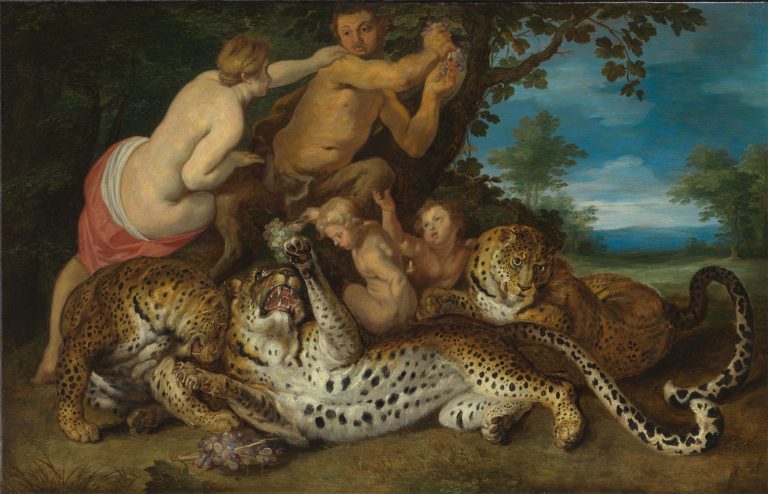In an idyllic scene at the edge of a forest, a satyr teasingly backs away from a nymph who reaches for the grapes in his hands. Two small boys in the center of the triangular composition romp blithely with three majestic leopards. Resting an arm on the neck of one of the beasts, the boy at the right gestures toward the nymph while the second boy—echoing the satyr’s gesture—teases the central leopard with another bunch of grapes. The playful interactions between the mythological figures, the children, and the leopards project a world of harmonious coexistence evocative of the mythological Golden Age. Popularized in western Europe by Ovid’s Metamorphoses (written in 7 A.D.), the Golden Age was celebrated for being the only one of mankind’s four ages in which nature and reason were in perfect harmony and humans were inherently good: “The Golden Age was first; when Man, yet new, no rule but uncorrupted Reason knew: And, with a native bent, did good pursue. Unforc’d by punishment, un-aw’d by fear.”1
Ovid’s Metamorphoses provided Dutch and Flemish artists with an almost endless source of subjects for history paintings, but none more than Peter Paul Rubens (1577–1640). Combining the lives of gods, goddesses, and mythological creatures with the observed natural world around him, Rubens’s realistic depictions of animals brought Greek mythology into a naturalistic setting that the viewer could understand. Rubens, largely inspired by Ovid, painted various images of the Golden Age, including Nymph and Satyr with Leopards, ca. 1618, a large canvas that he sold to Sir Dudley Carleton as part of an exchange for the latter’s collection of antiquities.2 The identification of this composition as an allegory of the Golden Age was already noted in 1793, when Rubens’s original painting—or another version of it—was in the collection of the Duc d’Orleans (fig 1).3
The Leiden Collection panel is a reduced copy of that composition. Rubens’s composition is seen hanging on a wall in Jan Brueghel the Elder’s Allegory of Sight and Smell, ca. 1620, in the Prado (fig 2). The Prado work indicates that Rubens’s composition had more foliage and a greater expanse of sky above the satyr’s head than the copy in the Leiden Collection, and a technical examination has revealed that the latter panel has been trimmed at the top.4
The Leiden Collection painting is the result of collaboration between at least two artists. The three stunningly lifelike leopards and the landscape may well be the work of Jan Brueghel the Younger (1601–78). The leopards are based on models found in the paintings of his father Jan Brueghel the Elder (1568–1625), which, in turn, were based on animal studies by Rubens. The central leopard, for example, is found in the famous Garden of Eden with the Fall of Man, ca. 1615, which Jan the Elder painted in collaboration with Rubens (fig 3). The head-butting leopard on the left appears in Jan the Elder’s vivid depiction of The Entry of the Animals into Noah’s Ark, 1613 (fig 4). The nymph, satyr, and the two boys were executed by a different hand, presumably someone trained in Rubens’s workshop. When this painting entered the Leiden Collection in 2005, these figures were attributed to Jan Boeckhorst (1604–68), but his figures have a very different character than those in this work.5 The broadly executed landscape may have been painted by an entirely different artist. Both Rubens and Jan Brueghel the Elder had large workshops that reproduced replicas of the masters’ works, and identifying individual hands in such paintings has proven to be extremely difficult.
